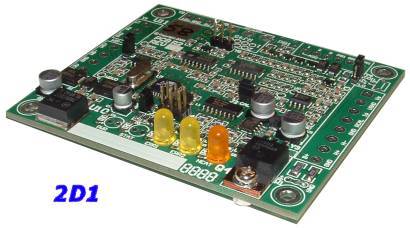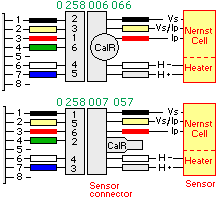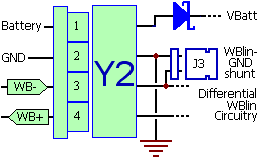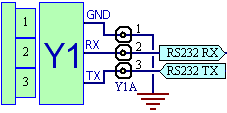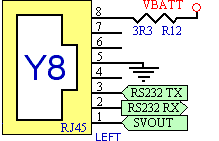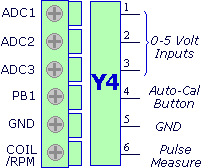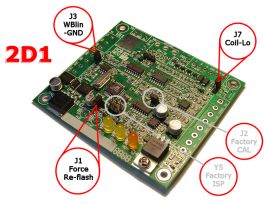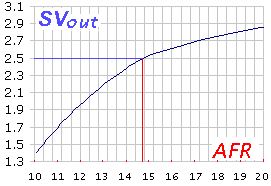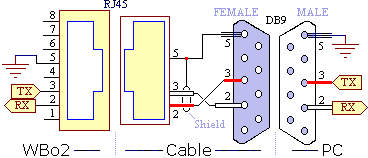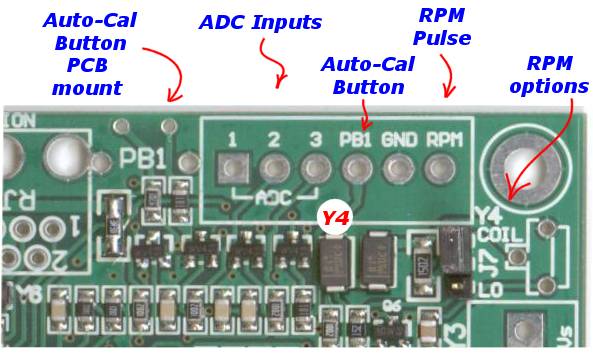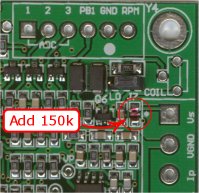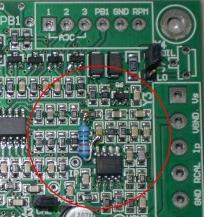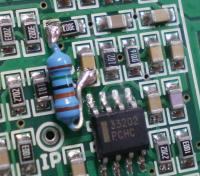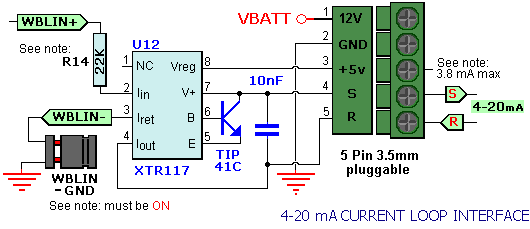WBlin+ Pin 4/Y2 & WBlin- Pin 3/Y2 Wideband Output
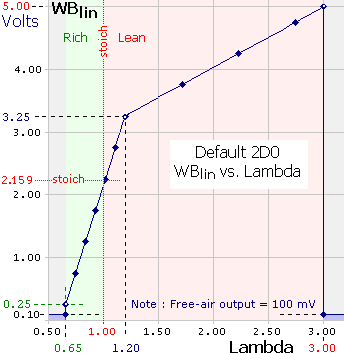
The WBlin output on 2D0 has default values a little different to other WBo2 units.
Remember that the WBo2 configuration program WButil.exe lets you change these defaults.
Dual Slope Linear Output
Rather than the default linear AFR = 9.0 to 19.0 span of WBo2's standard 0 to 5 Volt output
(see it here),
2D0 has a Lambda=0.65 to 3.0 span (*) over the 0.25 to 5.0 Volt range
in two linear segments centered about Lambda = 1.2 at 3.25 Volts.
This is shown in the graph at right.
(* equivalent AFR range is 9.56 to 44.1).
The effect of this is to reduce the resolution of the rich tuning range (AFR=9.6 to 17.6 covers 3.0 Volts)
at the expense of better resolution in the lean range.
The actual formula for the dual slope follows the general straight line formula y=mx+c.
In the formula below, L is Lambda, and V is voltage:
- Rich (L = 0.65 -> 1.2) : L = (0.55/3.0)*V + 0.60467
(ie. L = 0.18333*V + 0.60467)
- Lean (L = 1.2 -> 3.0) : L = (1.8/2.0)*V - 1.5
(ie. L = 0.9*V - 1.5)
Note very carefully, the rich graph starts at Lambda = 0.65 and a voltage of 0.25 Volts.
The lean graph ends at a Lambda of 3.0 and Voltage of 5.0.
Outside that range you should consult the next paragraph on Bounded Output.
Lastly, note that stoich (ie. Lambda = 1.0) has a voltage of 2.159 Volts.
To convert the above formulas to AFR, remember that:
- AFR = AFRstoich * Lambda.
Bounded Output
Another 2D0 feature is the setting of valid Lambda limits by clamping WBlin
to a fixed voltage when Lambda is higher or lower than the bounding limits.
This scheme allows a recording device to determine if the WB output is valid (must be greater than 100 mV).
The default Lambda bound limits are 0.65 and 3.0 and a bounding Voltage of 100 mV.
If Lambda is richer or leaner than these values then WBlin will be fixed at 100 mV.
In the image at right this is shown as the grey area to either side of the light green (rich) and the pink (lean) range.
The actual clamped value is shown down the bottom in the light blue region.
It's possible to change the clamp values for 2D0 by modifying configuration parameters.
The WButil.exe program is run, and in the Comms tab the
following commands are manually entered in the Command box.
The same program can re-program the output table(s) from the AFR Tables tab.
This sequence defeats the clamping action by setting the rich Ipx threshold limit to 0 and the lean limit to 0x3000.
- s6300 set low threshold (low) at 63 to 00 (hex value = rich Ipx threshold)
- s6400 set low threshold (high) at 64 to 00
- s6700 set high threshold (low) at 67 to 00
- s6830 set high threshold (high) at 68 to 30 (lean Ipx threshold)
- w write to update the EEPROM (takes a seconds or so)
Remember that if you reflash
the WBo2 unit with newer firmware, the setting entered above will be lost.
To automate the conversion of the standard 2D's dual slope settings to the 9-19 AFR settings over 0-5 Volts
(ie. that is found on other WBo2 units as standard),
use the 2D_0-5V_9-19AFR.zip and then use WButil to send it to the controller.
|  The 2D1 is Tech Edge's high quality SMD OEM wideband product for Bosch LSU (5 wire) sensors.
It is an updated version of the through-hole 2D0 board that we still actively sell.
2D1 is slightly smaller than 2D0 and has the robustness of surface mount (SMD) construction.
SMD is not so readily repaired but this isn't a problem as these units are very reliable
and we repair most of our customer's devices anyway.
The 2D1 is Tech Edge's high quality SMD OEM wideband product for Bosch LSU (5 wire) sensors.
It is an updated version of the through-hole 2D0 board that we still actively sell.
2D1 is slightly smaller than 2D0 and has the robustness of surface mount (SMD) construction.
SMD is not so readily repaired but this isn't a problem as these units are very reliable
and we repair most of our customer's devices anyway.
 The latest 2D1 PCB rev. can be ordered with analog 4-20 mA loop capability that is in addition to the 0-5 Volt WBlin 12 bit output.
More info on the 2D1L below.
The latest 2D1 PCB rev. can be ordered with analog 4-20 mA loop capability that is in addition to the 0-5 Volt WBlin 12 bit output.
More info on the 2D1L below.
